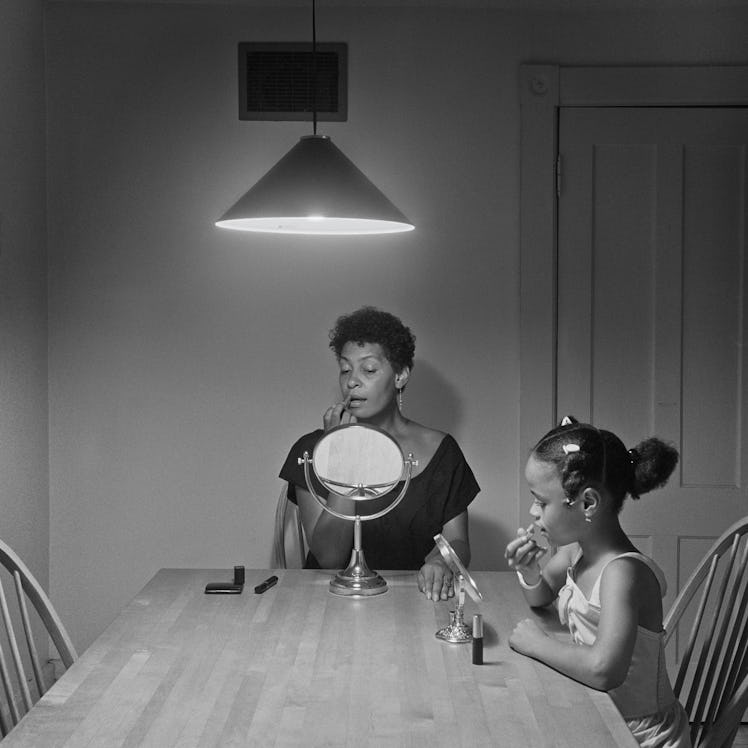Resting Our Eyes Exhibition Considers the Radical Act of Leisure for Black Women
The ICA San Francisco show features works from Sadie Barnette, LaKela Brown, Ebony G. Patterson, and many more.

Whether they knew it at the time or not, Tahirah Rasheed and Autumn Breon—two California-based curators—had the key theme for a compelling art show the very moment that they met. Rasheed, who hails from West Oakland, California; and Breon, a Los Angeles native, ran in similar circles for years (they were both in the youth group The Wide Awakes, have mutual artist friends including Hank Willis Thomas, and went to college at rival schools simultaneously). When they finally linked in person for a creative brainstorm, the two immediately admired each other’s accessories: the gleaming jewelry they both wore, their shiny tooth gems and grills.
“We realized Black women’s adornments are radical forms of self-love, expression, and activism,” Rasheed told me during a recent Zoom call with Breon.
“So we took it upon ourselves to map out the visual vocabulary for Black women’s freedom as it shows up in both our leisure and our adornment,” Breon added. “They’re essential ideas.”
The result is Resting Our Eyes, an exhibition running at ICA San Francisco January 25 through June 25 that features pieces from Carrie Mae Weems, Mickalene Thomas, Lorna Simpson, and many other art-world heavy weights. The works run the gamut in terms of medium: inside the white walls and exposed steel ceilings at the newly opened Bay Area museum, you’ll find photography from Weems; Lauren Halsey’s tactile, fringed wall art; neon lights; video installations, and other mixed media—but all the pieces speak to the central theme of relaxation and ornamentation as avenues for Black women’s freedom.
Derrick Adams, “Floater No. 2,” 2016.
Deborah Willis, “Carrie at the Euro Salon, Eatonville,” 2010.
Carrie Mae Weems, “The Blues,” 2017.
“When we started thinking about what kind of story we would want to tell for this exhibition, we kept coming back to the [queer Black feminist organization] Combahee River Collective’s idea of how the entire world benefits from Black women’s freedom,” Breon said.
“How we practice leisure is important because, historically our bodies have been criminalized,” Rasheed added. “It’s how we combat these terrible political views that are put on us.”
Ja’Tovia Gary. “Citational Ethics (Saidiya Hartman, 2017),” 2020.
LaKela Brown, “Composition With 35 Golden Doorknocker Impressions,” 2021.
While sussing out which artists and pieces would be included in the exhibition, the two curators kept coming back to the idea of featuring works that highlighted the beauty in the mundane. That concept is embodied in Thomas’s “Love’s Been Good To Me #2,” a large-scale painting of a Black woman draped in an evening gown with a high slit, as well as in the more abstract work of Sadie Barnette, whose tower of multicolored speakers, “Home Goods: Speaker Stack V,” is part of the show.
Sadie Barnette, “Home Goods: Speaker Stack V,” 2021.
Traci Bartlow, “Girl Boss,” 1996.
Lauren Halsey, “Untitled,” 2021.
Both Rasheed and Breon have unconventional backgrounds, at least when it comes to art. Rasheed, a Bay Area native whose parents were members of the Black Panther party, attended college at the University of California, Berkeley, where she studied medicine, integrative biology, and biomedical sciences. Breon majored in aeronautics and astronautics at Stanford University. Both have always used art as a form of activism and civic engagement—tenets of Black feminism, but also an important cultural facet of the San Francisco Bay Area. As such, the women have begun living out the topics they explore in Resting Our Eyes.
“The themes of leisure and adornment have become part of our co-curating relationship: we ask each other, Did you get some sleep? Did you get rest? Did you go out and get some air?” said Rasheed. “It’s a practice.”
Hank Willis Thomas, “Kama Mama, Kama Binti (Like Mother, Like Daughter),” 1971/2008, from Unbranded: Reflections in Black by Corporate America.
Helina Metaferia, “Headdress 1,” 2019.
Lorna Simpson, “Nebulae Fig. 85,” 2019.
“Both of our practices are centered in abolition,” Breon added. “And abolition is an entire framework that applies to how we work with each other. What’s central to that is facilitating care and not harm with the power you have. That’s something I hope people get from this: not only taking in these objects, but also thinking about how you can organize your life around those ideas.”